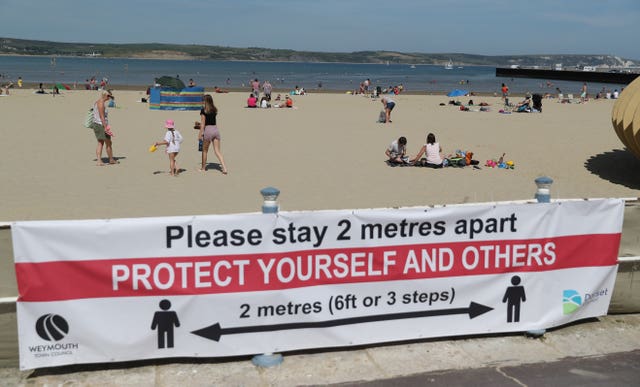
Physical distancing of at least one metre lowers the risk of coronavirus transmission, but distances of two metres could be more effective, a new study suggests.
Researchers found that keeping a distance of more than one metre from other people was associated with a much lower risk of infection compared with less than one metre.
The risk of infection when people stand more than a metre away from the infected individual was found to be 3%, and 13% if within a metre.
However, according to the analysis published in The Lancet, modelling suggests for every extra metre further away up to three metres, the risk of infection or transmission may halve.
In the UK people are advised to keep a distance of two metres from others, but there have been calls to reduce this to 1.5 metres – like in Germany, in order to help the hospitality sector reopen.
Places such as theatres and entertainment venues could be hit hard by the two-metre rule, which would severely restrict the number of patrons allowed inside.
The World Health Organisation (WHO) recommends people maintain a distance of at least one metre between each other.
The researchers looked at data from nine studies across Sars, Mers and Covid-19, including 7,782 participants.
Professor Holger Schunemann from McMaster University in Canada, who co-led the research, said: “Our findings are the first to synthesise all direct information on Covid-19, Sars, and Mers, and provide the currently best available evidence on the optimum use of these common and simple interventions to help ‘flatten the curve’ and inform pandemic response efforts in the community.
“Governments and the public health community can use our results to give clear advice for community settings and healthcare workers on these protective measures to reduce infection risk.”

According to the researchers, keeping at least one metre from other people as well as wearing face coverings and eye protection, in and outside of healthcare settings, could be the best way to reduce the chance of viral infection or transmission of Covid-19.
Thirteen studies focusing on eye protection found that face shields, goggles, and glasses were associated with lower risk of infection, compared with no eye covering.
They found that the risk of infection or transmission when wearing eye protection was 6%, and 16% when not wearing eye protection.
Evidence from 10 studies also found similar benefits for face masks in general, with risk of infection or transmission when wearing a mask 3%, and 17% when not wearing a mask.
Evidence in the study was looking mainly at mask use within households and among contacts of cases, and was also based on evidence of low certainty.
For healthcare workers, N95 and other respirator-type masks might be associated with a greater protection from viral transmission than surgical masks or similar, the researchers found.
For the general public, face masks are also probably associated with protection, even in non-healthcare settings, the researchers said.
Co-author Dr Derek Chu, assistant professor at McMaster University, said: “With respirators such as N95s, surgical masks, and eye protection in short supply, and desperately needed by healthcare workers on the front lines of treating Covid-19 patients, increasing and repurposing of manufacturing capacity is urgently needed to overcome global shortages.”
Researchers said that none of these interventions – even when properly used and combined – give complete protection from infection.
They noted the certainty of the evidence around face masks and eye protection is low.
The study, conducted to inform WHO guidance documents, looked at the available evidence from the scientific literature and is the first time researchers have systematically examined the optimum use of these protective measures in both community and healthcare settings for Covid-19.
The authors said their findings have immediate and important implications for curtailing the current pandemic, and future waves, by informing disease models, and standardising the definition of who has been “potentially exposed” for contact tracing.


Comments: Our rules
We want our comments to be a lively and valuable part of our community - a place where readers can debate and engage with the most important local issues. The ability to comment on our stories is a privilege, not a right, however, and that privilege may be withdrawn if it is abused or misused.
Please report any comments that break our rules.
Read the rules hereLast Updated:
Report this comment Cancel